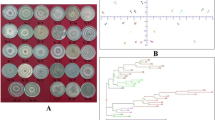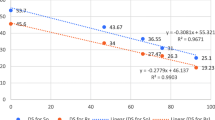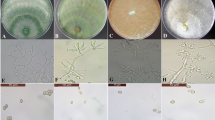Abstract
Trichoderma, soil-borne filamentous fungi, are capable of parasitising several plant pathogenic fungi. Twelve isolates of Trichoderma spp. isolated from different locations of South Andaman were characterized for their cultural, morphological and antagonistic activity against soil borne and foliar borne pathogens. The sequencing of these isolates showed seven different species. The isolates revealed differential reaction patterns against the test pathogens viz., Sclerotium rolfsii, Colletotrichum gloeosporioides and C. capsici. However, the isolates, TND1, TWN1, TWC1, TGD1 and TSD1 were most effective in percentage inhibition of mycelial growth of test pathogens. Significant chitinase and β-1,3-glucanase activities of all Trichoderma isolates has been recorded in growth medium. T. viride was found with highest chitinase whereas T. harzianum was recorded with highest β-1,3-glucanase activities.

Similar content being viewed by others
References
Samuels GJ (1996) Trichoderma: a review of biology and systematics of the genus. Mycol Res 100:923–935
Kumar A, Gupta JP (1999) Variation in enzyme activity of tubeconazole tolerant biotypes of Trichoderma viride. Ind Phytopathol 52:263–266
Kubicek CP, Penttila ME (1998) Regulation of production of plant polysaccharide degrading enzymes by Trichoderma. In: Harman GE, Kubicek CP (eds) Trichoderma and Gliocladium enzymes biological control and commercial applications, vol 2. Taylor and Francis Ltd, London, pp 49–71
Sivasithamparam K, Ghisalberti EL (1998) Seconday metabolism in Trichoderma and Gliocladium. In: Kubicek CP, Harman GE (eds) Trichoderma and Gliocladium basic biology taxonomy and genetics, vol 1. Taylor and Francis Ltd, London, pp 139–191
Harman GE (2000) Myth and dogmas of biocontrol; changes in perceptions derived from research on Trichoderma harzianum T-22. Plant Dis 84:377–393
Harman GE, Howell CR, Viterbo A, Chet I, Lorito M (2004) Trichoderma species-opportunistic, avirulent plant symbionts. Nat Rev Microbiol 2:43–56
Cruz L, Pinter-Toro JA, Benitez T, Llobell A (1995) Purification and characterization of an endo-β-1,3-glucanase from Trichoderma harzianum that is related to its mycoparasitism. J Bacteriol 177:1864–1877
Elad Y, Chet I, Henis Y (1982) Degradation of plant pathogenic fungi by Trichoderma harzianum. Can J Microbiol 28:719–725
Samuels GJ, Dodd SL, Gams W, Castlebury LA, Petrini O (2002) Trichoderma species associated with the green mold epidemic of commercially grown Agaricus bisporus. Mycologia 94:146–170
Raeder U, Broda P (1985) Rapid preparation of DNA from filamentous fungi. Lett Appl Microbiol 1:17–20
White TJ, Bruns T, Lee S, Taylor J (1990) Amplification and direct sequencing of fungal ribosomal DNA for phylogenetics. In: Innes MA, Gelfand DH, Sninsky JJ, White TJ (eds) PCR protocols: a guide to methods and applications. Academic, San Diego, CA, pp 315–322
Jukes TH, Cantor CR (1969) Evolution of protein molecules. In: Munro HN (ed) Mammalian protein 242 metabolism. Academic, New York, pp 21–132
Morton DT, Stroube NH (1955) Antagonistic and stimulatory effect of microorganism upon Sclerotium rolfsii. Phytopathology 45:419–420
Reissing JL, Strominger JL, Leloir LF (1955) A modified colorimetric method for estimation of N-acetylamine sugars. J Biol Chem 217:959–966
Rifai MA (1969) A revision of the genus Trichoderma. Mycol Pap 116:1–56
Bhagat S (2008) Biocontrol potential of Trichoderma spp. from Andaman and Nicobar Islands. PhD thesis, BCKV, West Bengal, India
Kuhls K, Lieckfeldt E, Samuels GJ, Kovacs W, Meyer W, Petrini O, Gams W, Borner T, Kubicek CP (1996) Molecular evidence that the asexual industrial fungus Trichoderma reesei is a clonal derivate of the ascomycete Hypocrea jecorina. Proc Natl Acad Sci USA 93:7755–7760
Kuhls K, Lieckfeldt E, Samuels GJ, Meyer WC, Kubicek P, Borner T (1997) Revision of Trichoderma sec. Longibrachiatum including related teleomorphs based on analysis of ribosomal DNA internal transcribed spacer regions. Mycologia 89:442–460
Ospina-Giraldo MD, Royse DJ, Thon MR, Chen X, Romaine CP (1998) Phylogenetic relationships of Trichoderma harzianum causing mushroom green mold in Europe and North America to other species of Trichoderma from world-wide sources. Mycologia 90:76–81
Blakeman JP, Fokemma NJ (1982) Potential for biological control of plant disease on the phylloplane. Ann Rev Phytopathol 20:167–192
Bankole SA (1990) Micro flora associated with cowpea phylloplane and their role in disease development and control. MSc thesis, University of Ibadan, Ibadan
Bhagat S, Pan S (2007) Mass multiplication of Trichoderma harzianum on agricultural byproducts and their evaluation against seedling blight of mungbean and collar rot of groundnut. Ind J Agric Sci 77:583–588
Bhagat S, Pan S (2008) Variability in production of extra cellular hydrolytic enzymes by Trichoderma spp. and induction of disease resistance in gram (Ciccer arietinum). J Biol Conserv 22:57–66
Carasolio CA, Gutierrez A, Jimenez B, Van Monkngu M, Herrera Estrella A (1994) Primary structures and expression pattern of the 33 kDa chitinase gene from the mycoparasitic fungus Trichoderma harzianum. Proc Natl Acad Sci USA 91:10903–10907
Ulhoa CJ, Peberdy JF (1991) Regulation of chitinase synthesis in Trichoderma harzianum. J Gen Microbiol 137:2163–2169
Elad Y, Chet I (1983) Improved selective media for isolation of Trichoderma spp. and Fusarium spp. Phytoparasitica 11:55–58
Acknowledgments
This research was supported by grants from the project “Application of Microorganisms in Agriculture and Allied Sectors” of the NBAIM-ICAR, UP, Mau, India. We thank the Head Division of Field Crops, CARI for constant support and encouragements during the course of study.
Author information
Authors and Affiliations
Corresponding author
Rights and permissions
About this article
Cite this article
Kumar, K., Amaresan, N., Bhagat, S. et al. Isolation and Characterization of Trichoderma spp. for Antagonistic Activity Against Root Rot and Foliar Pathogens. Indian J Microbiol 52, 137–144 (2012). https://doi.org/10.1007/s12088-011-0205-3
Received:
Accepted:
Published:
Issue Date:
DOI: https://doi.org/10.1007/s12088-011-0205-3




